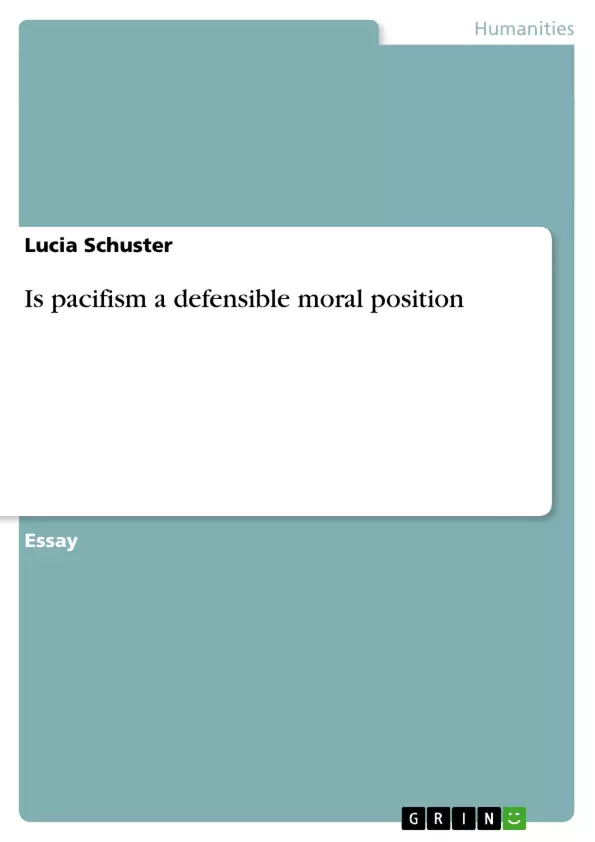There are plenty of ideas in international ethics which indicate how states and
individuals should behave and interact. The belief that the use of violence in contact
with others is wrong, represents one of those. Pacifists, fascinated by a world without
war or violence, formed different moral positions according to that vision. To have a
moral position means that a person or a state must have general kinds of reasons "for
supposing a certain type of act to be his [or its] duty, in a moral sense" (Wasserstrom
R., p. 66). Pacifism describes a duty that might range from non-resistance to any sort of
physical attack, up to the attitude to use force only in case of self-defence. In the first
part of this essay the debate will therefore focus on the individual and whether or not
pacifism can be made a plausible moral principle for our private lives. Passive and
active non-resistance and self-defence will be the main viewpoints discussed in this
section. It will be followed by debatable moral standpoints for a nation as a whole in the
second chapter. We will determine, if it is imaginable and desirable for a state to adopt
perspectives like 'no force at all', 'no war' or 'wars only in the case of self-defence', as its
righteous. To provide evidence for the moral verification of pacifist views, we firstly have
to prove whether or not they can possibly be moral positions and secondly if they are
defensible. However, it will be shown, that moral positions are defensible, if one has
plausible reasons to believe that this specific vision is likely to be realised. [...]
Table of Contents
- Is pacifism a defensible moral position?
- Individual Pacifism: Passive and Active Non-Resistance and Self-Defense
- State Pacifism: 'No Force at All', 'No War', and 'Wars Only in Self-Defense'
Objectives and Key Themes
This essay examines the moral defensibility of pacifism, both at the individual and state levels. It explores various pacifist viewpoints, from passive and active non-resistance to the use of force in self-defense. The essay analyzes the feasibility and desirability of these positions within different contexts, considering both religious and secular perspectives.
- The moral implications of violence and non-violence.
- The feasibility of passive and active non-resistance in individual and state contexts.
- The role of religion and morality in shaping pacifist perspectives.
- The limitations and potential consequences of different pacifist approaches.
- The moral justification for self-defense.
Chapter Summaries
Is pacifism a defensible moral position?: This essay investigates the moral arguments surrounding pacifism, exploring diverse perspectives ranging from absolute non-resistance to self-defense. It analyzes pacifism's roots in religious beliefs, particularly the sanctity of life, and examines the contrasting approaches of passive and active non-resistance, using Gandhi's philosophy as a prominent example of active non-violent resistance. The essay delves into the challenges of implementing pacifism at both individual and state levels, questioning its practical application and assessing the potential consequences of complete non-resistance. The discussion extends to the complex issue of self-defense, exploring whether it is reconcilable with pacifist principles and considering consequentialist and deontological perspectives on the use of force. The essay aims to determine whether plausible justifications exist for adopting pacifism as a moral stance in various contexts.
Keywords
Pacifism, non-violence, self-defense, morality, ethics, religion, passive resistance, active resistance, Gandhi, state, individual, justice, violence.
Frequently Asked Questions: Is Pacifism a Defensible Moral Position?
What is the overall purpose of this text?
This text is a comprehensive preview of an essay examining the moral defensibility of pacifism, both individually and at the state level. It explores various pacifist viewpoints, their feasibility, and their implications within different contexts, considering religious and secular perspectives.
What are the key themes explored in the essay?
The key themes include the moral implications of violence and non-violence; the feasibility of passive and active non-resistance; the role of religion and morality in shaping pacifist perspectives; the limitations and potential consequences of different pacifist approaches; and the moral justification for self-defense.
What types of pacifism are discussed?
The essay discusses individual pacifism, encompassing both passive and active non-resistance and self-defense. It also examines state pacifism, exploring variations such as "no force at all," "no war," and "wars only in self-defense."
How does the essay approach the topic of self-defense?
The essay explores the complex issue of self-defense within the context of pacifism, examining whether it is reconcilable with pacifist principles and considering both consequentialist and deontological perspectives on the use of force.
What perspectives are considered in the essay?
The essay considers both religious and secular perspectives on pacifism, drawing upon philosophical arguments and real-world examples such as Gandhi's philosophy of active non-violent resistance.
What are the chapter summaries about?
The chapter summaries provide an overview of the essay's main arguments, detailing the exploration of diverse pacifist viewpoints, the challenges of implementing pacifism at individual and state levels, and the analysis of the moral justifications for pacifism and self-defense.
What are the key words associated with this essay?
Key words include: Pacifism, non-violence, self-defense, morality, ethics, religion, passive resistance, active resistance, Gandhi, state, individual, justice, violence.
What is the intended audience for this preview?
This preview is intended for academic use, supporting structured analysis of themes within the essay.
- Quote paper
- Lucia Schuster (Author), 2002, Is pacifism a defensible moral position, Munich, GRIN Verlag, https://www.grin.com/document/13829



